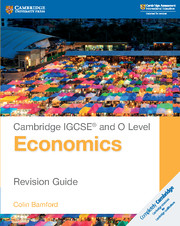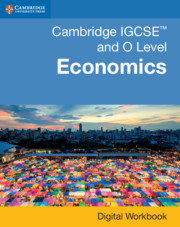Economics relates to every aspect of our lives, from the decisions we make as individuals to the structures created by governments and firms. Thinking like an economist can help us all make better choices. With exam-style questions and specific skills practice, this revision guide helps students build their knowledge and understanding of economic theory, giving them confidence to achieve their potential in examinations. Answers are at the back of the book so that students are free to self-study.
Features
- Sample questions and example answers highlight important skills when answering questions.
- Exam-style multiple choice questions at the end of every chapter give students regular opportunities to practise their skills and boost confidence in preparation for assessment.
- Exam-style data response questions at the end of each section give students practice analysing information.
- Progress check questions encourage students to reflect on their learning and build their knowledge.
Table of Contents
- Introduction
- Section 1. The basic economic problem
- 1. The nature of the economic problem
- 2. Factors of production
- 3. Opportunity cost
- 4. Production possibility curves
- Exam-style structured questions for Section 1
- Section 2. The allocation of resources
- 5. Microeconomics and macroeconomics
- 6. The role of markets in allocating resources
- 7. Demand
- 8. Supply
- 9. Price determination
- 10. Causes of price changes
- 11. Price elasticity of demand
- 12. Price elasticity of supply
- 13. Market economic system
- 14. Market failure
- 15. Mixed economic system
- Exam-style structured questions for Section 2
- Section 3. Microeconomic decision makers
- 16. Money and banking
- 17. Households
- 18. Workers
- 19. Trade unions
- 20. Firms
- 21. Firms and production
- 22. Firms' costs, revenue and objectives
- 23. Market structure
- Exam-style structured questions for Section 3
- Section 4. Government and the macroeconomy
- 24. The role of government
- 25. The macroeconomic aims of government
- 26. Fiscal policy
- 27. Monetary policy
- 28. Supply-side policy
- 29. Economic growth
- 30. Employment and unemployment
- 31. Inflation and deflation
- Exam-style structured questions for Section 4
- Section 5. Economic development
- 32. Living standards
- 33. Poverty
- 34. Population
- 35. Differences in economic development between countries
- Exam-style structured questions for Section 5
- Section 6. International trade and globalisation
- 36. International specialisation
- 37. Free trade and protection
- 38. Foreign exchange rates
- 39. Current account of balance of payments
- Exam-style structured questions for Section 6
- Suggested Answers
- Glossary.
Advice on useful tools
Advice on useful tools, activities and timetabling from teachers experiencing school closures.
Cambridge GO
All our supporting resources have now moved to Cambridge GO – the new home for your Cambridge digital content.
Listen to our podcast
Listen to our podcast to discover teaching inspiration & advice from leading educational thinkers.








